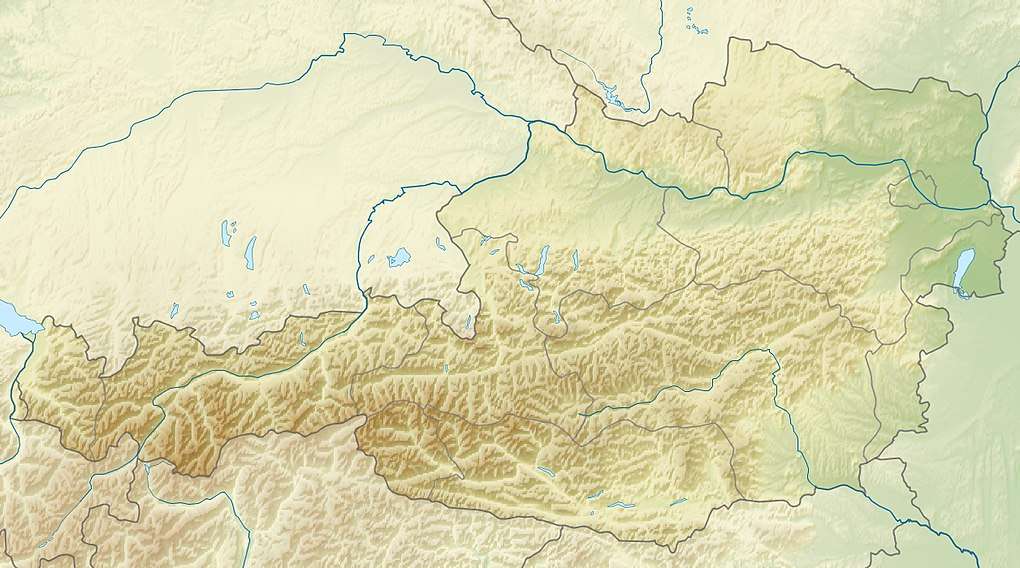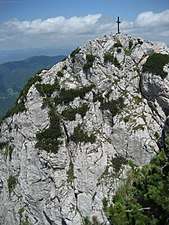Graz Highlands
The Graz Highlands or Graz Mountains (German: Grazer Bergland) are a low mountain range north of the Styrian state capital of Graz in Austria. It is part of the Central Alps and forms the start of the Prealps East of the Mur. From a geological perspective, regions on the west bank of the Mur, which are clearly separate from the building of the Styrian Prealps, belong to the Graz Highlands.
| Graz Highlands Grazer Bergland | |
|---|---|
Characteristic landscape of alms and crags: view from the Tyrnauer Alm to the Rote Wand | |
| Highest point | |
| Peak | Hochlantsch |
| Elevation | 1,720 m above sea level (AA) |
| Dimensions | |
| Length | 30 km (19 mi) |
| Geography | |
 | |
| State | Styria, Austria |
| Range coordinates | 47°21′46″N 15°25′27″E |
| Parent range | Prealps East of the Mur, Lavanttal Alps, Central Alps, Alps |
| Geology | |
| Orogeny | Mittelgebirge |
| Age of rock | Silurian to Carboniferous |
| Type of rock | limestones, dolomite, slate |
Location
The Graz Highlands are a low mountain massif in the north of the Styrian Hills and lie mainly east of the River Mur.
The core area of settlement is the Passail Basin, the adjacent Semriach Basin to the southwest and the Teichalm region to the north.
Boundaries
The Graz Highlands are bounded:
- in the west by the Mur valley from Mixnitz to the northern city limits of Graz. By geological definition certain parts west of the Mur are also counted as part of the Graz Highlands, especially those which belong to the Graz Palaezoic, such as the Plabutsch Buchkogelzug
- in the north by the Breitenauertal (valley containing Breitenau am Hochlantsch) and the valley of the Gasenbach. Other definitions view it as the line from Mixnitzbach via Teichalm to Gasen
- in the northeast by the upper Feistritz valley
In the south and southeast the Graz Highlands transition into the East Styrian Hills and Graz Basin.
Mountains
The most important summits are the:
- Hochlantsch (1,720 m)
- Osser (1,548 m)
- Rote Wand (1,505 m)
- Schöckl (1,445 m)
- Zetz (1,274 m)
- Röthelstein (1,263 m)
- Hochtrötsch (1,239 m)
- Schiffall (1,221 m) and Kreuzkogel (1,181 m)
- Pleschkogel (1,061 m)
- Hohe Rannach (1,018 m)
- Generalkogel (713 m)
- Eggenberg (707 m)
Gallery
 Summit of the Hochlantsch
Summit of the Hochlantsch Teichalm region
Teichalm region Ascent through the Bärenschützklamm gorge
Ascent through the Bärenschützklamm gorge- Katerloch
 Schüsserlbrunn pilgrimage church
Schüsserlbrunn pilgrimage church
Literature
- Helmut Flügel: Die Geologie des Grazer Berglandes. 2nd edn., Graz, 1975, = Mitteilungen der Abteilung für Geologie, Paläontologie und Bergbau am Landesmuseum Joanneum, Sonderheft 1 (1. Aufl. Erläuterungen zur Geologischen Wanderkarte des Grazer Berglandes 1 : 100,000. hsg. Geologische Bundesanstalt, Vienna, 1960; pdf, at museum-joanneum.at).
| Wikimedia Commons has media related to Graz Highlands. |